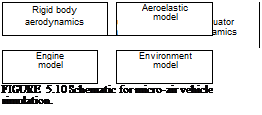MAV DYNAMICS
Biologically inspired MAVs are small autonomous flying vehicles. Their dimension could be smaller than 15 cm, or sometimes smaller than 300 cm, latter toward mini-air vehicles (MiAVs). MAVs are used for reconnaissance over land, in buildings, for collecting evidence of industrial faults, and for survey over hazardous places or nuclear sites. For design and development of these vehicles one needs to understand aerodynamics, structural aspects, and propulsion physics at a very small scale. Due to their small size, there would be limited or no space to carry avionics, which would otherwise carry out various navigation tasks [14].
Operational challenges of MAVs are related to low Reynolds number (^10e + 4), presence of gust and obstacles at low altitudes, microsize and weight, need for compact power pack, microsensors and actuators, and aeroelastic coupling. MAVs (and MiAVs) could be fixed wing, rotary wing, or flapping wing. Flapping wing flight is exhibited by millions and millions of species (bats, birds, and insects). A flapping wing MAV can be viewed as a single nonlinear dynamical system with integrated fluid, structure, and control systems components.
Research in the areas of MAVs can offer new and computationally efficient solutions to problems of design, propulsion/energy efficiency, structural aspects, machine vision, and navigation. Currently, the research is focused in three main areas:
• Research to study the aerodynamic characteristics of low-aspect ratio wings at low Reynolds number.
• Wind tunnel experiments for flow visualization. Aerodynamic coefficients in the form of lookup tables of stability, dynamic, and control derivatives are also obtained from such experiments.
• Numerical simulation based on CFD and wind tunnel experiments.
 |
 |
|
Today, autonomous aerodynamic control of MAVs is of much interest. The issues of flight mechanics and flight control for MAVs are of particular concern. In general, MAV dynamics can be modeled using the well-established set of rigid body EOMs for aircraft. Since MAVs are extremely light and susceptible to gusts, a possible way to avoid the degradation in their performance due to gusts is to build MAVs with higher flexibility [15]. Flexible MAVs will have the ability to absorb the wind energy and reduce the effect of gust, thereby improving the MAV’s overall performance. Models for simulation of MAV dynamics would therefore also require appropriate representation of flexibility effects in aerodynamic models. Figure 5.10 shows a simplistic layout of the simulation model for MAV.














